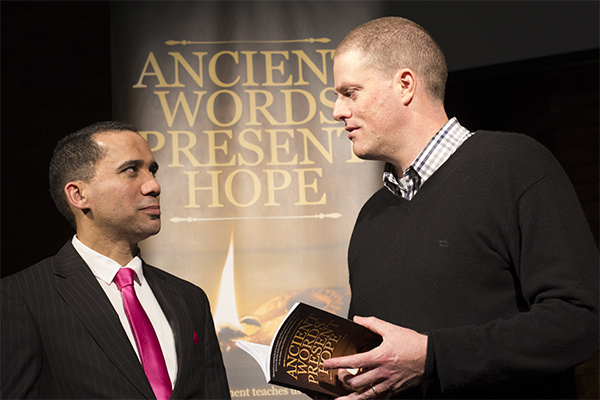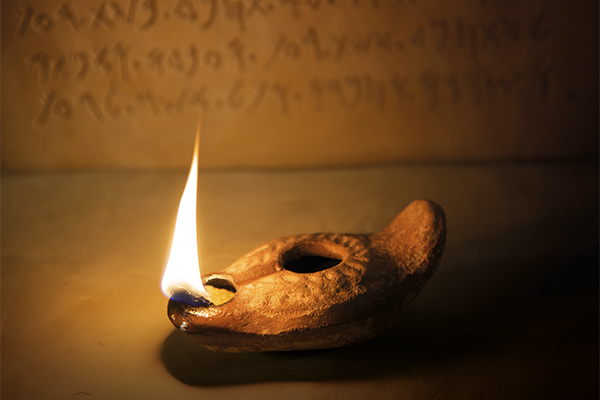Five principles for studying John’s use of the Old Testament in Revelation give us a better understanding of this book.
The principles are part of our belief in the inspiration of Scripture and, as spiritual scuba divers, give us the opportunity to explore the depths of the book’s riches.
1. Jesus is at the core of Revelation and we must use His methods to interpret the book
Jesus is the central person in the book; it is a Christian apocalypse. In Revelation 1:5, Jesus is identified as the faithful witness, firstborn of the dead, ruler of the kings of the earth. The voice of Jesus directs the book at critical moments (see Revelation 1:10; 10:4, 8; 16:15; 22:7, 12, 16) and Jesus is identified as the “One like the Son of Man” (Revelation 1:13), an obvious allusion to Daniel 7:13. This was one of the well-loved sayings to come from the lips of Jesus while on earth and now He takes on this distinctive title again in Revelation. Jesus is also the author of the seven letters (see Revelation 2:1, 8, 12, 18; 3:1, 7, 14) and meets the churches at their point of need, based on the circumstances they face. He directs the opening of each of the seven seals and is present in the symbols of Revelation 8:2-5 that point to the centrality of His death. He is the Lamb and the Child who rules with a rod of iron (see Revelation 12:4, 5). Finally, Jesus is also the rider on the white horse (see Revelation 19:15) coming to conquer those who have opposed His gospel and persecuted His people. All these symbols point to the centrality of Jesus in the visions John received on Patmos.
John had the privilege of being with Jesus in His ministry and seeing Him perform His mighty miracles. He even had the joy of resting on Jesus’ shoulder. From being a loud, boisterous fisherman, John was transformed by the love of Jesus. His writings are filled with not just human love but the agape love God came to give us in Jesus. He writes, “Beloved, let us love because God is love” (1 John 4:8, 9, NIV). He writes that we will see Jesus when He comes and that we shall be like Him for we shall see Him as He is (see 1 John 3:2). John must have longed for that day. It must have been a meaningful experience for John to now see Jesus in vision. Now in a glorified state but the same Jesus he had talked to and ministered with, the same Jesus who had calmed the angry seas and fed thousands, was now enthroned in heaven. These visions must have had a powerful effect on John and he had no doubt about their fulfilment.
Jesus confounded His critics not just by quoting Scripture but by identifying Himself as the One about which the Scriptures were speaking. In His first sermon, Jesus said, “Today this scripture is fulfilled in your hearing” (Luke 4:21, NIV). To His opponents, Jesus replied: “You diligently study the Scriptures because you think that by them you possess eternal life. These are the Scriptures that testify about me” (John 5:39, NIV).
Accordingly, both the Old and New Testaments are important for developing a comprehensive biblical theology of Revelation. This takes seriously the self-consistency of Scripture and the unified message Scripture conveys in the person and work of Jesus Christ. The writers of the New Testament understood Christ to be the fulfilment of the basic intent of the whole Old Testament.
2. The Old Testament context must be taken into account when interpreting Revelation
Since John was part of the first-century world, he used the writing practices of his contemporaries. David Instone-Brewer has demonstrated that the rabbis around the time of Jesus studied their sacred texts with due consideration for the literary and thematic context of a passage they were studying. Brewer summarises the conclusions to his research: “The predecessors of the rabbis before 70 AD did not interpret Scripture out of context, did not look for any meaning in Scripture other than the plain sense, and did not change the text to fit their interpretation, though the later rabbis did all these things.”
We must take the whole message of Daniel 2 into account when interpreting Revelation. Daniel 2 has all the elements in the development of biblical eschatology, meaning the study of the teachings and doctrines of the end-times, including the Second Coming. In Daniel 2, Nebuchadnezzar had a dream no-one, not even his wise men, could interpret. In answer to specific prayer, God gave Daniel the same dream, together with its interpretation. In his prayer of thanks for this “revelation,” Daniel pointed out that Yahweh sets up and brings down kings, asserting that Yahweh is in control of all that happens. Further, Daniel 2 records the rise of political powers that will oppress and oppose God’s people; the image itself representing the “abomination of desolation”; judgment symbolised by the stone striking the image; the stone representing Christ; and the defeat of cosmic evil in the establishment of God’s kingdom.
Daniel 2:28 and 45 refer to the mountain that will fill the whole earth. This image must influence our understanding of the use of Daniel 2 in the structural development of Revelation. The concept of an animate, expanding stone, or mountain, was commonplace in the Ancient Near East as ancients regarded the world as a living body and pointed to its centre as a navel, the place of nourishment. This dependence on the navel meant the ancients often viewed it as the place of worship, specifically the temple. This helps explain Daniel 2:28 and 45. The dream of Daniel 2 depicts the navel stone par excellence, growing into a living mountain and filling the whole earth. John then understands the domination of the kingdom of God over the kingdoms of the world has begun to grow since the inauguration of the kingdom of God in the death and resurrection of Jesus Christ.
3. Covenant promises made to Israel in the Old Testament are reinterpreted in the context of the new people of God—the church
The manner in which John uses Old Testament symbolism points to a re-orientation of the focus and meaning of the symbols. Ben Witherington highlights the seven gold candlesticks in Revelation 1:12, which indicate a temple setting. A seven-armed menorah symbolised Judaism but, in Revelation’s description, the symbol is transformed—the seven are separated. Witherington asserts this points to a full representation of God’s people in each church, as well as the church being composed of Jew and Gentile united in Christ and that the church now is the fulfilment of Israel as the eschatological people of God.
This one example highlights the fact that the coming of Christ re-oriented the understanding and perspective not only of John, but also of all the New Testament writers. On the road to Emmaus, Christ spoke to the two disciples who were filled with doubt and uncertainty: “And beginning with Moses and all the Prophets, he explained to them what was said in all the Scriptures concerning himself” (Luke 24:27, NIV, emphasis added). After this time of study, the disciples responded by saying their hearts burned within them as Christ “opened the Scriptures to us” (Luke 24:32, NIV). Jesus had the ability to open minds and the Scriptures.
As the Messiah, Christ recapitulated—or went over—Israel’s history in His life and ministry, conquering where Israel had failed. For example, Israel failed in the wilderness, while Jesus succeeded. The New Testament writers’ experiences with Jesus sent them back to Scripture to re-read and re-study. They understood Christ as the fulfilment of the Old Testament, and so the Old Testament writings took on fresh meaning and spoke in relevant ways to the church, the Israel of God (see Galatians 6:16). Moreover, when we examine the passages used by John from the Old Testament, we find he did not choose passages at random but selected them from the Old Testament in which Israel were to be a blessing to the nations. Thus, John carries God’s plans for the human family to its logical conclusion: the provision of salvation for all who believe. For example, in the Old Testament covenant claims of God’s marriage to Israel (consider Isaiah 54:5; Jeremiah 3:14), we discover a reinterpretation of Christ’s cosmic marriage to His celestial bride (see Revelation 19:7–9).
4. What is portrayed locally in the Old Testament is reinterpreted universally in Revelation
David’s triumph over Jerusalem when he fought against the Jebusites and his standing as victor with his soldiers on Mount Zion (see 2 Samuel 5:6–8) is a case in point. This local victory is recast as a cosmic victory of the Lamb over the dragon and his evil associates. The Lamb now stands on Zion with the victorious 144,000 (see Revelation 14:1–5). The interplay between the local and universal is also seen in John extending the promises God made to Israel to the nations of the world.
A significant example of this is when John views not only the Aaronic priesthood but the entire throng of the redeemed as priests in Revelation 1:6. This is a careful development from Exodus 19:5 where God expressed His intention to make all Israel a kingdom of priests. Peter applied this text to the New Testament church (1 Peter 2:5) and John extended this to include all the redeemed. John’s universalising technique is also evident in Revelation 14, where six times John stresses the final harvest will be a harvest of “the earth” (see Revelation 14:14–20). The Bible tells us the gospel will be proclaimed to the whole world (see Revelation 14:6, 7; 18:1; Matthew 24:14), and Revelation 14:14–20 tells us of the worldwide extension of God’s judgment and the second coming of Jesus.
Another instructive example of John’s gospel key is his statement in Revelation 1:7 when he announces, “Look, he is coming with the clouds, and every eye will see him, even those who pierced him; and all the peoples of the earth will mourn because of him.” Some 500 years before Christ, Zechariah had predicted: “And I will pour out a spirit of compassion and supplication on the house of David and the inhabitants of Jerusalem, so that, when they look on the one whom they have pierced, they shall mourn for him, as one mourns for an only child, and weep bitterly over him, as one weeps over a firstborn. . . . The land shall mourn, each family by itself” (Zechariah 12:10, 12, NRSV). Zechariah announced a scandalous event in Jerusalem’s future: she would reject and “pierce” her own Messiah, and afterward “mourn for him as one mourns for an only child” (Zechariah 12:10, NIV). John alludes to this Messianic prediction, and adds his universalising emphasis: “every eye will see him” and “all the peoples of the earth will mourn because of him” (Revelation 1:7, NIV). John explicitly expands the original meaning of Zechariah’s prophecy to a worldwide scale.
5. The literal in the Old Testament becomes the spiritual in Revelation
The symbols in Revelation are abstract and spiritual but the stories from which they are drawn are concrete and literal. The literal city of Babylon is recast as an abstract and religious opponent of God and His people (see Jeremiah 51; compare Revelation 17–18). Similarly, the earthly becomes the heavenly in Revelation. The earthly sanctuary is used as a model to portray the heavenly sanctuary. As Revelation is primarily a spiritual book, we must be careful not to confuse the symbols for what they represent.
Links

A new revelation
Avondale academic’s Old Testament reading of New Testament prophecy Read more
A clear centre amid the chaos
Book launch a reminder of Bible prophecy’s true role Read moreShare

